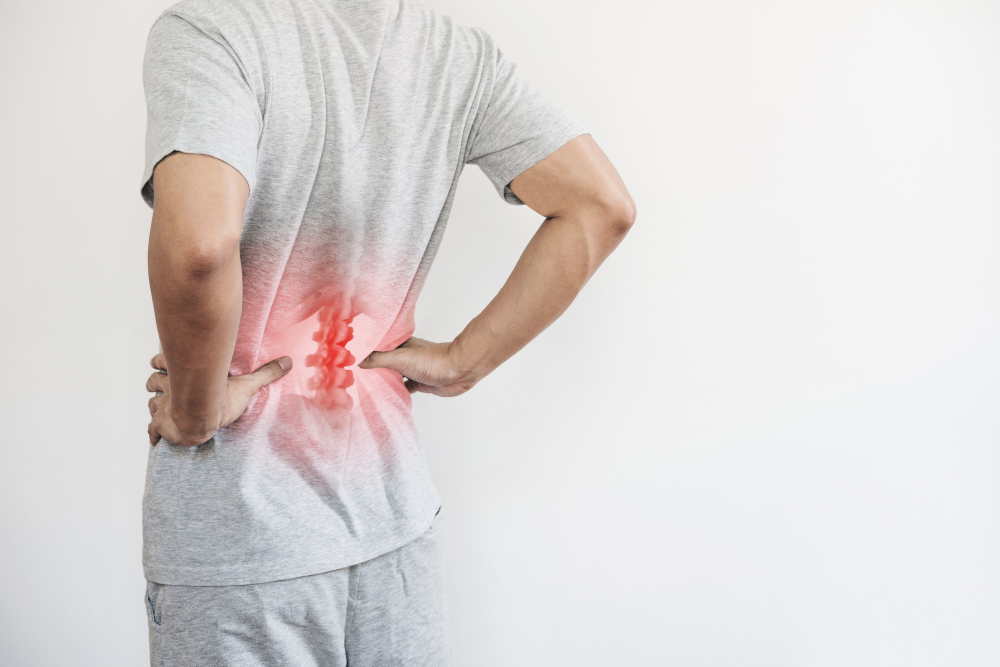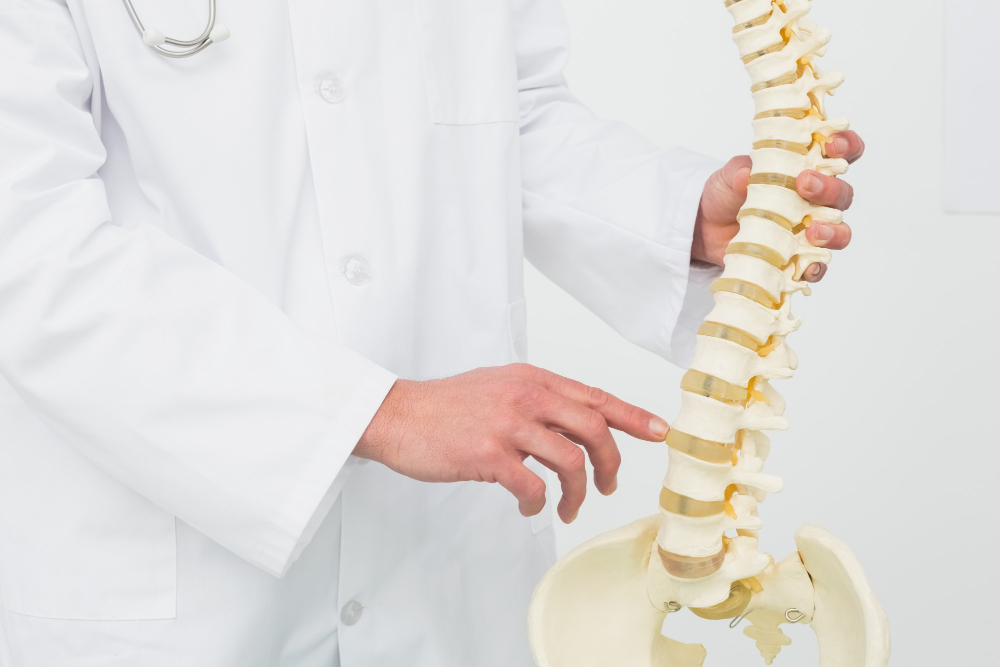What is a lumbar discectomy?
Lumbar discectomy involves extracting a damaged or slipped disc in the lower part of the spine through a surgical procedure. It requires an incision in the back muscle area to extract the disc that is pressing on the nerve. The option of discectomy may be suggested if the pain in the leg or back continues even after using medication or physical therapy, or if there are indications of nerve dysfunction, such as leg weakness or numbness. The surgery can be done in two ways – open or minimally invasive.

Who is a candidate?
If you have certain conditions, you might be a suitable candidate for a discectomy.
- There are various diagnostic examinations, including magnetic resonance imaging (MRI), computed tomography (CT), and a myelogram, that can reveal the presence of a herniated disc.
- If you experience considerable discomfort, diminished strength or a loss of sensation in your leg or foot.
- leg pain (sciatica) worse than back pain
- Indications that have not shown progress with the help of treatments involving exercise or drugs.
- Cauda equina syndrome involves the weakening of the legs, a lack of sensation in the genital region, and the inability to control bladder and bowel movements.
A possible treatment option for leg pain originating from the posterior lumbar region is a discectomy.
- A bulging or herniated disc occurs when the soft substance inside the disc protrudes or breaks through a weak part of the outer layer (annulus). This can result in inflammation and swelling as the leaked substance compresses a nerve, causing discomfort.
- The natural deterioration of disks in the spine can result in the formation of bone spurs and inflammation in the facet joints. The disks become dry and smaller, causing them to lose their ability to act as a cushion and become more rigid. The space between the disks also decreases, which can result in stenosis and the herniation of disks.
Why might I need a lumbar discectomy?
If you are experiencing weakness, pain or tingling in your lower back or leg due to a herniated disc, it may be necessary for you to undergo surgery.
Not all instances of back pain can be treated with Lumbar discectomy, and not all individuals who have a herniated disc require the surgery. If you experience severe symptoms even after attempting other treatments, like physical therapy and anti-inflammatory medications, your healthcare provider may recommend surgery.
Discuss with your healthcare provider regarding the advantages and disadvantages of minimally invasive surgery in contrast to open surgery. Minimally invasive surgery might entail reduced discomfort and quicker recuperation. Nevertheless, not all medical facilities have the capability to execute this procedure.
Types of discectomy

Generally, there exist five different varieties of discectomy.
Lumbar discectomy
Lumbar discectomy is a surgical procedure that involves the removal of a portion of the damaged intervertebral disc to alleviate nerve pressure. It is conducted on the lower part of the back or the lumbar spine and can be done either through an open surgery or a minimally invasive approach commonly referred to as “keyhole” surgery.
Posterior cervical discectomy
A cervical discectomy involves the elimination of a disc from the cervical spine, which is carried out on the neck region. To join two cervical vertebrae, an implant or artificial disc is frequently used during this operation.
Anterior cervical discectomy
An anterior cervical discectomy is like a cervical discectomy as it involves the removal of a cervical spine disc, but it is done through the front of the neck as opposed to the back.
Microendoscopic discectomy
The microendoscopic discectomy is a procedure that utilizes small cuts to carry out a discectomy, while ‘open’ surgeries demand bigger incisions to have a direct view of and cure the area. Bigger incisions provide better access to the affected disc.
Discectomy fusion
A surgical intervention called discectomy fusion combines two individual vertebrae into a solitary section of bone. This technique can be performed by using interbody cages or actual bone.
The Procedure
A surgery called discectomy is carried out while the patient is under anesthesia. The duration of the surgery is subject to various elements such as the size of the patient and the extent of the disc herniation. During the surgery, the patient lies facing downwards, while their back is directed towards the ceiling.

To eliminate a portion of a herniated disc, the surgeon will create a cut in the middle of your back. Typically, the incision measures approximately 3 centimeters. The next step is for the surgeon to meticulously separate the muscles from the spine bone. Special instruments are employed to get rid of a small quantity of bone and ligament from the rear of the spine, which is referred to as a laminotomy.
After eliminating the bone and ligament, the surgical expert can get a clear view and secure the spinal nerves. The next step involves getting rid of the herniated disc fragment, followed by a possibility of removing additional disc material to prevent its recurrence in the future. Finally, once the nerve area is cleared from the disc waste, the surgeon stitches up the incision and places a dressing on it.
Recovery and prevention
Book a subsequent meeting with your surgeon two weeks post-operation. Certain individuals may require physical therapy.
The duration of the healing period changes from one to four weeks depending on the disease being treated and your overall health condition. You may experience discomfort at the location where the cut was made, and you may not see immediate relief from the initial pain after the procedure. Make sure to try to maintain a hopeful outlook and consistently carry out any instructed physical therapy movements.
Individuals with jobs that do not involve physical labor can typically resume work within a maximum of 4 weeks following treatment. However, those employed in positions that involve the lifting of heavy weights or the operation of heavy machinery may need to wait for a minimum of 8 to 12 weeks before returning to work.
It is frequent to experience back pain multiple times, and the way to prevent its recurrence is through prevention measures.
- Proper lifting techniques
- Maintaining correct body positioning when seated, standing, engaged in physical activity, and while sleeping is important for overall physical health.
- Appropriate exercise program
- An ergonomic work area
- Healthy weight and lean body mass
- can have a significant impact on a person’s well-being and quality of life. By maintaining a positive attitude in the face of challenges, people are better able to cope with difficult situations and maintain a sense of resilience. Furthermore, practicing relaxation techniques such as deep breathing, meditation, or yoga can help to reduce stress and promote a sense of calmness, which can in turn improve both mental and physical health.
- No smoking
Results
In individuals with obvious indications of a compressed nerve, such as leg pain that radiates down the legs, a diskectomy can alleviate herniated disk symptoms. Nevertheless, the relief achieved from this procedure may not be long-term since it does not address the root cause of the disk injury or herniation.
To avoid further harm to the spine, one could aim for a healthy weight, maintain a nutritious eating habit, engage in low-impact physical activities, and restrict actions that involve recurrent bending, torsion or lifting.
Treatment in Türkiye:
The medical staff of surgical teams, doctors and consultants in Rehab Türk can provide the best treatment options and free consultations – by striving to keep abreast of the latest medical technologies and methods.

